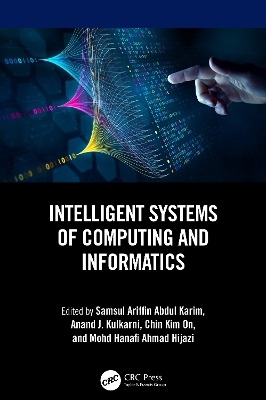
Intelligent Systems of Computing and Informatics
CRC Press (Verlag)
978-1-032-50946-4 (ISBN)
Since 2011, the Fourth Industrial Revolution (IR4.0) has played a significant role in education, research, and industry. Data technologies have also evolved rapidly to cater to the rapidly growing size of the data as well as to enhance the security of the shared data through multiple resources and platforms.
Intelligent Systems of Computing and Informatics aims to develop a new Intelligent Systems of Computing and Informatics (ISCI) to cater to the needs of industries in line with the United Nations’ Sustainable Development Goals (SDGs) of affordable and clean energy and sustainable cities and communities.
Comprising 20 chapters by experts from all over the world, this book covers such topics as data technologies, machine learning, signal and image processing, software systems efficiency, computer networking, Internet of Things, and computational intelligence for real-life problems.
Key Features:
Develops a new system for computing and informatics
Provides the state of the art of current research and studies in intelligence systems
Written by experts in the field of computing and informatics
This book is aimed at postgraduate students, researchers working in various research and development (R&D) agencies, and practitioners, as well as scientists that have an interest in ISCI.
Samsul Ariffin Abdul Karim is an Associate Professor with Software Engineering Programme, Faculty of Computing and Informatics, Universiti Malaysia Sabah (UMS), Malaysia. Anand J Kulkarni is currently working as Professor and Associate Director of the Institute of Artificial Intelligence at the MITWPU, Pune, India. Chin Kim On is currently working as an Associate Professor at the Universiti Malaysia Sabah in the Faculty of Computing and Informatics. Mohd Hanafi Ahmad Hijazi is an Associate Professor of Computer Science at the Faculty of Computing and Informatics, Universiti Malaysia Sabah in Malaysia. Anand J Kulkarni holds a PhD in Distributed Optimization from Nanyang Technological University, Singapore, MS in Artificial Intelligence from University of Regina, Canada, Bachelor of Engineering from Shivaji University, India and Diploma from the Board of Technical Education, Mumbai. He worked as Research Fellow at Odette School of Business, University of Windsor, Canada. Anand worked with Symbiosis International University, Pune, India for over six years. He is currently working as Professor and Associate Director of the Institute of Artificial Intelligence at the MITWPU, Pune, India. KIM ON, CHIN received his PhD in Artificial Intelligence with the Universiti of Malaysia Sabah, Sabah, Malaysia during 2010 and he is currently working as an Associate Professor at the Universiti Malaysia Sabah in the Faculty of Computing and Informatics. His research interests are gaming AI, evolutionary computing, evolutionary robotics, artificial neural networks, image processing, agent technologies, sentiment analysis, evolutionary data mining, and biometric security system with mainly focused on fingerprint and voice recognition. Mohd Hanafi Ahmad Hijazi is an Associate Professor of Computer Science at the Faculty of Computing and Informatics, Universiti Malaysia Sabah in Malaysia. He obtained his PhD from the University of Liverpool in 2012. His research work addresses the challenges in knowledge discovery and data mining to identify patterns for prediction on structured and/or unstructured data; his particular application domains are medical image analysis and understanding, sentiment analysis on social media data, and recently precision farming.
Preface. Editors. Contributors. Chapter 1 Intelligent Systems of Computing and Informatics: An Overview. Chapter 2 Intelligent Application of Partial Least Square Algorithm in Developing Model of Fat Depth Measurement. Chapter 3 Single Feature Imbalance Classification on Ensemble Learning Methods for Efficient Real-Time Malware Detection. Chapter 4 Electroencephalogram-Based Emotion Recognition Using Binary Bat Algorithm and Least Square Support Vector Machine. Chapter 5 Sequential Exception Technique for Text Anomalies. Chapter 6 Intelligence Predictive Model for Lamb Carcass C-Site Fat Depth Using Support Vector Machine. Chapter 7 Exploring the Power of Convolutional Neural Networks in Face Detection. Program. Chapter 9 Intelligence Random Forest Application in Developing Regression Model from Lamb Carcass C-Site Fat Depth Data. Chapter 10 Intelligent Identification System for MOOC Security. Chapter 11 Low Illumination Surveillance for Object Detection and Recognition Using Deep Learning Methods. Chapter 12 Intelligent System Design for the Solutions of Nonlinear Diffusion in the Two-Dimensional Porous Medium. Chapter 13 Improved False Position Method Based on Slope (IFPMS). Chapter 14 Computing of Anxiety or Depression Symptoms Indicators Using Lagrange Exponential Modified Euler Method. Chapter 15 Hybridization of Simulated Kalman Filter and Minimization of Metabolic Adjustment for Succinate and Lactate Production. Chapter 16 Intelligent Air Conditioning Systems: Enhancing Energy Efficiency and Indoor Air Quality through IoT and Air Conditioning Unit Using Machine Learning. Chapter 17 A Comprehensive Analysis of Air Quality Data: A Case Study Approach with the OpenAir Package in R. Chapter 18 A Systematic Review on Intelligent Mobile Beacon Systems: Applications and Features. Chapter 19 Enhancing the Use of Simulation Software with Artificial Intelligence Methods for Clean Energy System Performance. Chapter 20 Intelligent Systems of Computing and Informatics: An Extension. INDEX.
| Erscheinungsdatum | 13.06.2024 |
|---|---|
| Zusatzinfo | 66 Tables, black and white; 94 Line drawings, black and white; 17 Halftones, black and white; 111 Illustrations, black and white |
| Verlagsort | London |
| Sprache | englisch |
| Maße | 156 x 234 mm |
| Gewicht | 657 g |
| Themenwelt | Informatik ► Theorie / Studium ► Künstliche Intelligenz / Robotik |
| Technik ► Elektrotechnik / Energietechnik | |
| Technik ► Umwelttechnik / Biotechnologie | |
| ISBN-10 | 1-032-50946-5 / 1032509465 |
| ISBN-13 | 978-1-032-50946-4 / 9781032509464 |
| Zustand | Neuware |
| Haben Sie eine Frage zum Produkt? |
aus dem Bereich


